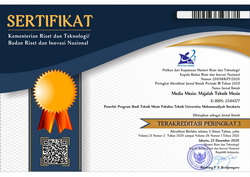THE EFFECT OF THERMAL ANNEALING BETWEEN GLASS TRANSITION TEMPERATURE AND CRYSTALLIZATION TEMPERATURE ON DIMENSIONAL ACCURACY OF 3D PRINTED PART
The Jaya Suteja(1*), Michael Evan(2), Sunardi Tjandra(3)(1) Universitas Surabaya
(2) Universitas Surabaya
(3) Universitas Surabaya
(*) Corresponding Author
Abstract
The dimensional accuracy of a 3D printed part affects the function, strength, and assembly process of the part. This study aims to determine the effect of the implementation of thermal annealing process on the dimensional accuracy of Polylactic Acid parts printed by Fused Filament Fabrication. This research uses 32 factorial design methodology with two replications. Two investigated parameters of the thermal annealing process are the annealing temperature and the holding time. The annealing temperature is set between the glass transition temperature and the crystallization temperature, which are 65 °C, 75 °C, and 85 °C. The holding times used are 45 minutes, 60 minutes, and 75 minutes. The response of this research is the dimensional deviation in the X, Y, and Z directions. Based on the experiment result, it was found that the use of higher annealing temperature increases the X, Y, and Z-direction deviations. The analysis result indicates that the use of annealing temperature slightly above the glass transition temperature results in a low degree of crystallization but produces higher dimensional accuracy than annealing temperature below the crystallization temperature. While the use of a holding time of 60 minutes increases the deviation in the X and Z directions but decreases the deviation in the Y direction.
Keywords
Full Text:
PDFReferences
T. J. Suteja and A. Soesanti, “Mechanical Properties of 3D Printed Polylactic Acid Product for Various Infill Design Parameters: A Review,” J. Phys. Conf. Ser., vol. 1569, no. 4, 2020, doi: 10.1088/1742-6596/1569/4/042010.
J. Suteja, H. Firmanto, A. Soesanti, and C. Christian, “Properties investigation of 3D printed continuous pineapple leaf fiber-reinforced PLA composite,” J. Thermoplast. Compos. Mater., 2020, doi: 10.1177/0892705720945371.
J. Butt and R. Bhaskar, “Investigating the effects of annealing on the mechanical properties of FFF-printed thermoplastics,” J. Manuf. Mater. Process., vol. 4, no. 2, pp. 1–20, 2020, doi: 10.3390/jmmp4020038.
P. Geng et al., “Effect of thermal processing and heat treatment condition on 3D printing PPS properties,” Polymers (Basel)., vol. 10, no. 8, 2018, doi: 10.3390/polym10080875.
A. Lee, M. Wynn, L. Quigley, M. Salviato, and N. Zobeiry, “Effect of Temperature History During Additive Manufacturing on Crystalline Morphology of Polyether Ether Ketone,” 2021, [Online]. Available: http://arxiv.org/abs/2109.04506.
R. Wang, K. J. Cheng, R. C. Advincula, and Q. Chen, “On the thermal processing and mechanical properties of 3D-printed polyether ether ketone,” MRS Commun., vol. 9, no. 3, pp. 1046–1052, 2019, doi: 10.1557/mrc.2019.86.
S. Iannace, L. Sorrentino, and E. Di Maio, Biodegradable biomedical foam scaffolds, no. IV. Woodhead Publishing Limited, 2014.
V. Slavković, N. Grujović, A. Disic, and A. Radovanović, “Influence of Annealing and Printing Directions on Mechanical Properties of PLA Shape Memory Polymer Produced by Fused Deposition Modeling,” Int. Congr. Serbian Soc. Mech., no. June, pp. 1–8, 2017.
L. Wang, W. M. Gramlich, and D. J. Gardner, “Improving the impact strength of Poly(lactic acid) (PLA) in fused layer modeling (FLM),” Polymer (Guildf)., vol. 114, pp. 242–248, 2017, doi: 10.1016/j.polymer.2017.03.01
Article Metrics
Abstract view(s): 637 time(s)PDF: 567 time(s)
Refbacks
- There are currently no refbacks.








